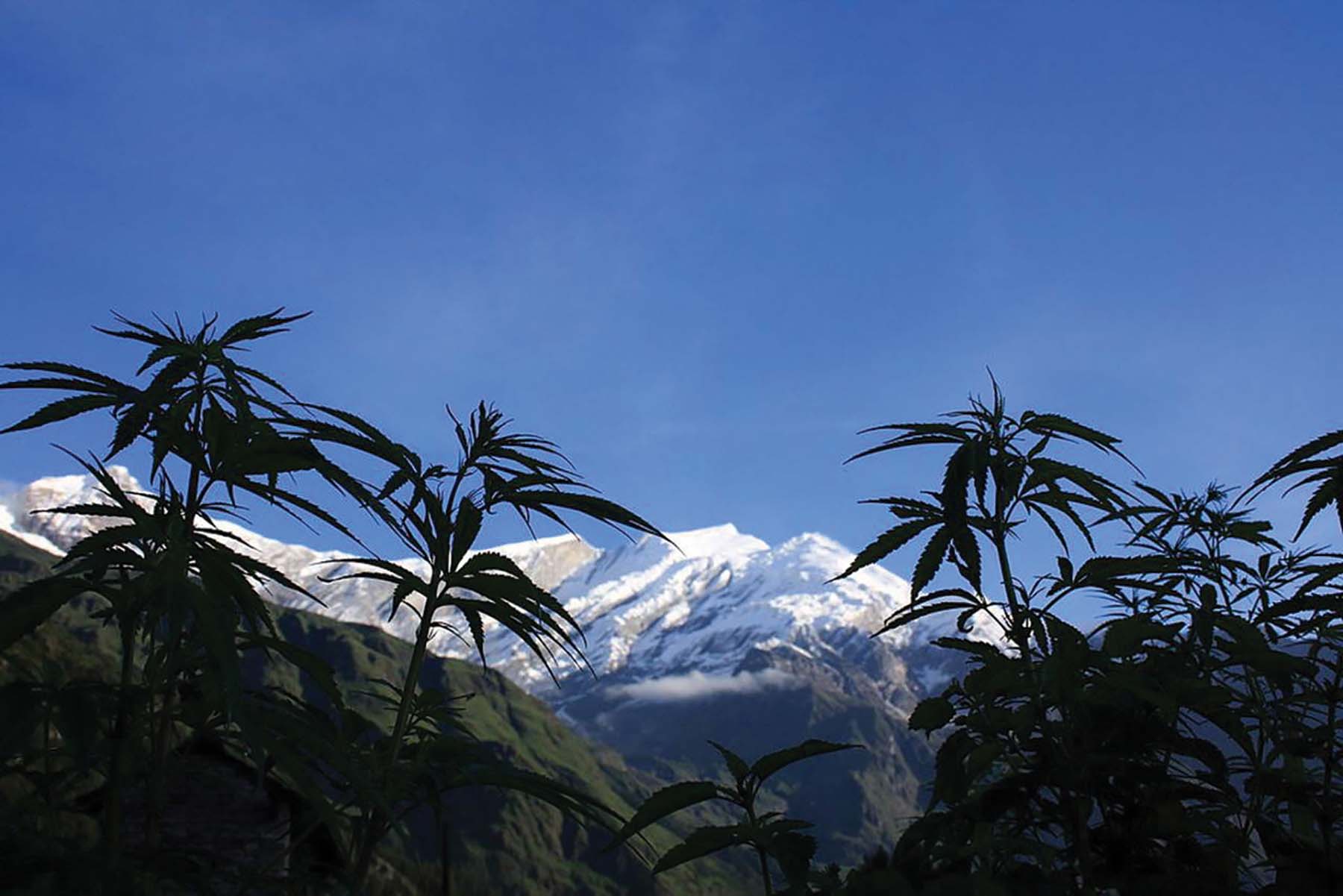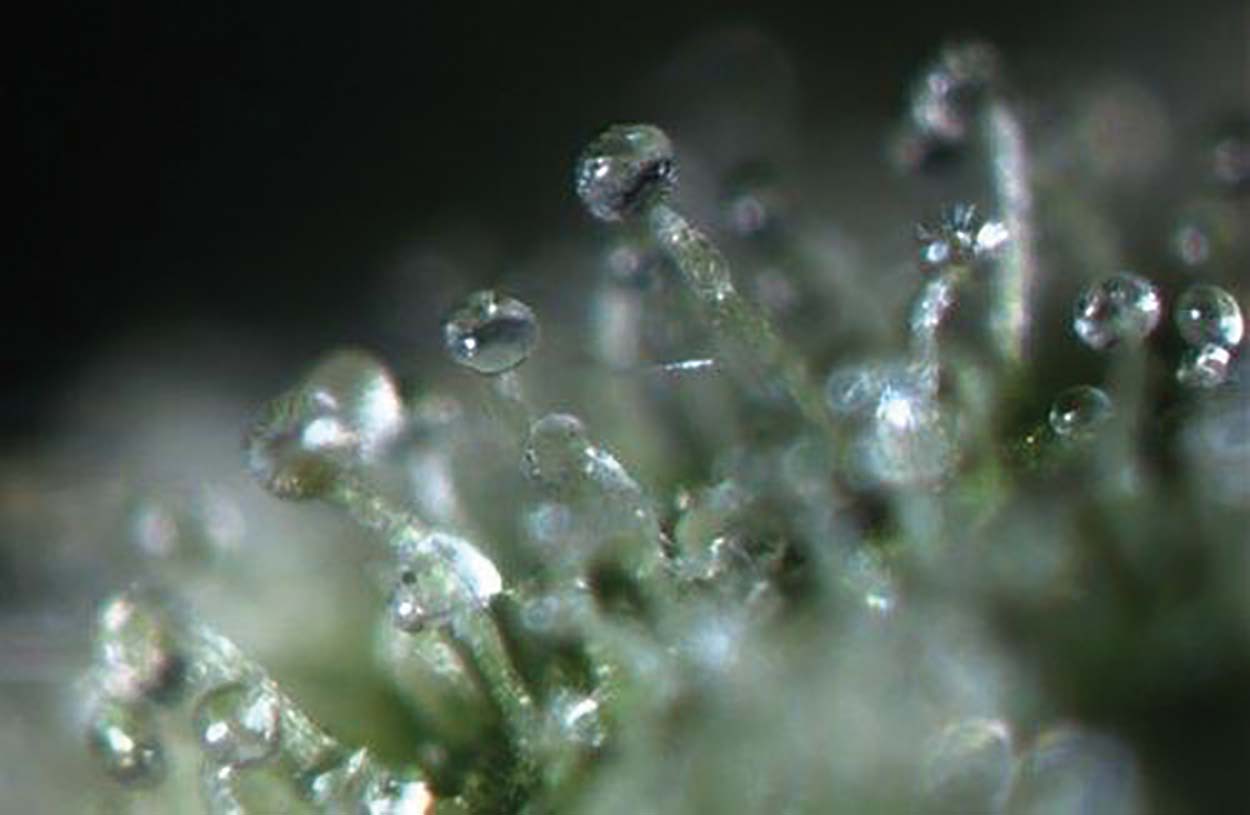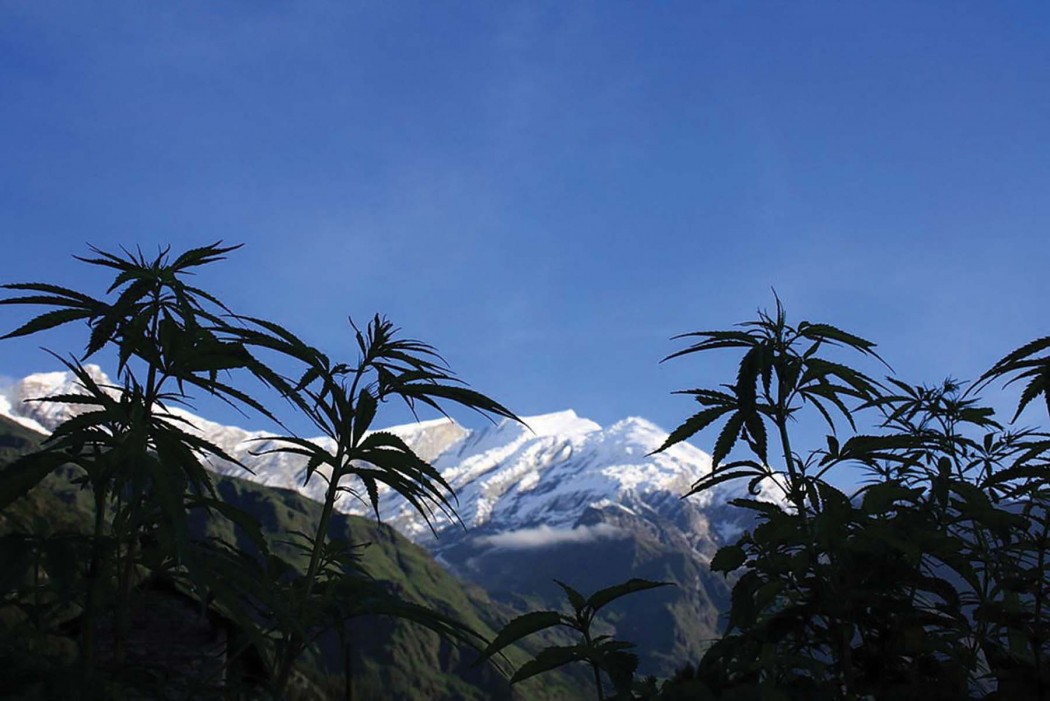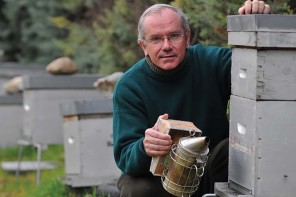by Sharon Schmidt
Very little research appears in the literature about how honey bees interact with cannabis plants containing levels of THC appropriate for recreational or medical use. In fact, only one scholarly article about the interaction between cannabis plants and bees can be found. So what are the biologic and physiological relationships between cannabis and Apis mellifera?
When I became a beekeeper I located some of my bee hives on a property that has beautiful land resources. The property owners grow organic plants and flowers during the summer and have a clean and continuously running stream a few yards away from the hives. The hives are situated facing south-east and the area has a big thicket of tall, mature plants on the north side of the hives to protect against winter winds. Pigs in a neighboring field stir up and then loll around in puddles of muck during Spring and Summer and sometimes the bees seem attracted to the puddles. The community gardens, visible from the property interest the bees a great deal. The setting is idyllic and the bees proved to be good pollinators.
I had no warning that my bees would eventually be in the middle of a cannabis grow. However on the day that Oregon law changed to allow citizens to grow cannabis, an odor that some described as “heavenly” and others referred to as “skunk-like” emanated from the fields.

When I told people that my bees now had access to cannabis, the reaction was always the same; they asked whether the bees were “buzzed” (intoxicated) and whether their honey would make people “high” (also intoxicated). I was fascinated by this question! Would we (quite unintentionally) produce psychoactive honey? This began a line of inquiry on my part to determine whether bees are interested in cannabis, what they might glean from it nutritionally and the effects of cannabis on bees and bee products.
I had an opportunity to check on the hives on at least a weekly basis and hoped to make some observation of what the bees might be harvesting. I was disappointed though. Observation of the bees revealed that there was apparently no interaction in spite of the abundance of plants and close proximity of cannabis plants to the hives.
Why not? One hypothesis was that the bees were not attracted to the aroma of cannabis plants. Bees have an exquisite olfactory sense that they use to detect pheromones of other bees and to find nectar. They are also attracted to colors and these two appeals to the senses are like neon billboards for finding food and mating opportunities. Cannabis does not have these attributes.
Thus, there are reasons that bees would not find cannabis attractive. There is also an absence of specific information suggesting attractiveness of cannabis (to bees) in the literature. However an apparently contradictory piece of video footage turned up on social media. The video showed seemingly excited honey bees buzzing around and alighting upon a cannabis plant from which they appeared to be feeding (Nicolas Trainerbees, 2015).
Many viewers seeing that footage probably believe that the bees derived some chemical excitement from their contact with the plant. However this is very unlikely because bees have no neuroreceptors that would allow them to apprehend the psychoactive elements present in cannabis.
In their 2001 article, “Cannabinoid receptors are absent in insects” (Mcpartland, J, DiMarzo, V, De Petrocellis, L, Mercer, A, Glass, M), the authors revealed that insects do not produce arachidonic acid which is a precursor of necessary ligands. It is thought that the CB (cannabinoid) receptor was lost in insects over the course of evolution. The authors also noted that the CB receptor appears to be the only known neuroreceptor that is present in mammals and absent in insects. Because of its documented absence, we can reliably say that bees are unable to experience cannabis in the same way humans do.
The next often asked question fielded by this writer is whether honey made by bees having access to cannabis plants contains THC and whether it exerts a psychoactive effect on those consuming it.
The cannabis plant is mostly wind pollinated and therefore has not evolved to attract bees. It does not produce a smell that would attract bees, nor is it colorful and finally, and most importantly, it is unable to provide a reward in the form of floral nectar. As those familiar with Apis mellifera know, it is nectar and not pollen that is required by bees to make honey. But the male plant does provide pollen in some circumstances.

The existing scholarly article on the topic (Dalio, J.S., 2012) notes that cannabis pollen seems to be a food of last resort for bees. The author notes that bees (in India where the observations occurred) turned to cannabis plants as a source of protein but only visited male plants during times of dehiscence when the male plant’s reproductive organs released pollen and that bees were only interested in that pollen during a pollen dearth.
So how can we account for the reports of persons who say they have seen bees congregating and apparently foraging on female plants or of the images available on the social media site? Seeking answers, this writer approached Norman Carreck (Science Director and Senior Director of Journal of the Apiculture Research) who suggested that the possible source of the female plant’s attractiveness to bees could be “extra floral nectaries” documented as an attribute of the cannabis plant by John Free (1970) in his book, Insect Pollination of Crops (personal communication with Mr. Carreck, January 20, 2016). Extra floral nectaries include glands residing outside the calyx producing both water and sugars. There are no formal reports of extra floral nectaries in cannabis plants other than the one previously referenced by John Free (1970). However if cannabis plants are shown to have these, they could serve a defensive purpose by attracting ants which then serve as guards protecting the plant from herbivores – or they might serve to attract bees. However, cannabis is known to have glandular trichomes (plant hairs that secrete fluid), which could also be a plant feature interesting to bees (personal communication with Dr. Marjorie Weber, Postdoctoral Fellow, Center for Population Biology, UC Davis, January 21, 2016).
In cannabis plants, bulbous type trichomes are the smallest at 15-30 microns and are barely visible. Capitate-sessile trichomes measure from 25-100 microns across and capitate-stalked trichomes measure from 150-500 microns and are the most abundant. The latter contain the majority of the psychoactive cannabinoids (THC, THCV, CBN) and the effects of use are at least partly mediated by how much degradation is allowed prior to harvest. It appears that trichomes have evolved for the purpose of making a plant less tasty to animals and insects (Anonymous, 2016) making the idea that bees are feeding from trichomes less plausible and more likely that they might be collecting resin from them.
In another discussion with noted entomologist, Dr. Dewey Caron, more ideas were advanced. First, that another naturally occurring source of interest for bees called “honeydew” is often the object of their interest. Honeydew is simply the waste product of scale or other sucking insects which cannabis is likely to host. These tiny insects probably concentrate their feeding (and excretion) at the tender surfaces of new plant growth and produce tasty waste products that bees might feed on. Second, is the possibility that bees might be collecting resins for purposes of making propolis (a sticky bee product used by them to sanitize, reinforce and weatherproof the hive) and third, that bees demonstrating activity on cannabis plants might even be seeking moisture from irrigation (personal communication with Dr. Caron January 21, 2016).
Presently, it seems that some aspects of the relationship between bees and cannabis are not yet verified. Judging from statements occurring in public discourse, misinformation about bees, cannabis and honey based upon legend and lore exists among some of the public.
Much may yet be discovered, but some hypotheses are more likely true than others: First, it appears that bees cannot experience altered neurophysiology as a result of exposure to cannabis given that they have no neuroreceptors for the chemical it contains. Second, the literature suggests that they do not prefer cannabis pollen but will resort to visiting male plants and collecting pollen from them mostly during a floral dearth. Third, if bees congregate and appear to be feeding upon female plants it is not to collect floral nectar because cannabis does not produce flowers containing nectar; there is no known reason for the plant to produce nectar to attract pollinators due to the fact that it has evolved as a wind pollinated plant. However the plant may produce water and sugars if extra floral nectaries are proved to be present in this plant which could account for observations and anecdotes about bees congregating there.
Fourth, it is possible that an extra floral plant exudate might be used by Apis mellifera to make honey and one can speculate about the presence of the precursors of psychoactive chemicals. It seems unlikely though unless the bees are actually foraging on trichomes. Trichomes have evolved to protect the plant from the predatory interests of animals and insects so the idea of bees foraging from them seems unlikely. The common use of the term “sugar” to describe the frosty looking trichomes which have become opaque may further cloud the issue, bringing some to equate trichomes with sweetness. In fact, people who advocate juicing cannabis reference the need to mix it with other vegetable juice to cut the bitter taste. Generally bees do not seem to seek out bitter fluids.
Fifth, even if the resulting honey did contain such alkaloids, bee products would not be psychoactive without heat being applied for the purpose of converting alkaloids from an inactive to an active state (decarboxylation). Thus persons reporting a high after eating raw honey made by bees having access to cannabis are much more likely to be reporting a psychological phenomenon rather than a physiological one.
Finally, bees have an affinity for honeydew (waste products of scale and other insects that inhabit and forage in cannabis plants) therefore any interest bees demonstrate toward this plant could be based on the presence of honeydew, or even due to bees’ interest in collecting moisture or resin.
A final possibility is that bees might be trained to collect whatever substances are available from the plant as a result of experiencing a conditioning paradigm. Under such circumstances they might learn to associate the plant odor with a reward (sugar water) which could account for the enthusiasm they appear to be showing in the referenced video.
Future observation will likely yield more information about cannabis and about how Apis mellifera interacts with this plant.
Insofar as is known, no one has examined the composition of contents of the gut of bees appearing to forage on cannabis or even the composition of their propolis. No micro observation of their interaction with the plant is readily available either. Given the novelty of legal cannabis farming in some of the American states it seems likely that there will finally be more interest and opportunity for systematic observation and research allowing anecdotal reports and scientific data to be accurately reconciled.
References
Anonymous. (www.cannabis.com, Publisher). (January 25, 2016) retrieved from http://cannabis.com/faqs/growing/curing-what-are-trichomes-trichome-101.html
Dalio, J.S. Cannabis sativa- an important subsistence pollen source for apis mellifera. IOSR J. of Pharmacy and Biological Sciences (IOSRJPBS) ISSN: 2278-3008 Volume 1, Issue 4 (July-August 2012), PP 01-03
Free, J. (1070. Insect pollination of crops. London, New York: Academic Press.
Mcpartland, J, DiMarzo, V, De Petrocellis, L, Mercer, A, Glass, M. Cannabinoid receptors are absent in insects. Journal of Comparative Neurology, 2001 Aug 6, Vol 463(4), pp423-429.
Nicolas Trainerbees (Publisher). (November 10, 2015) Retrieved from (no title) https://www.facebook.com/nicolas.trainerbees/videos/10153622273364836/?theater
Sharon Schmidt holds a doctoral degree in Clinical Psychology and is a Psychiatric Nurse Practitioner. She is a beekeeper, a student of beekeeping and volunteer Director for the Oregon Honey Festival / Cascade Girl Organization (www.oregonhoneyfestival.com) dedicated to supporting small beekeeping operations and connecting people and bee culture through science. The author extends thanks to Mr. Phillip Brand, Dr. Dewey Caron, Mr. Norman Carreck, Mr. Gooey Rabinski, Dr. Ramesh Sagili, Dr. Sidney Schnoll, Dr. Robin Thorp and Dr. Marjorie Weber.






